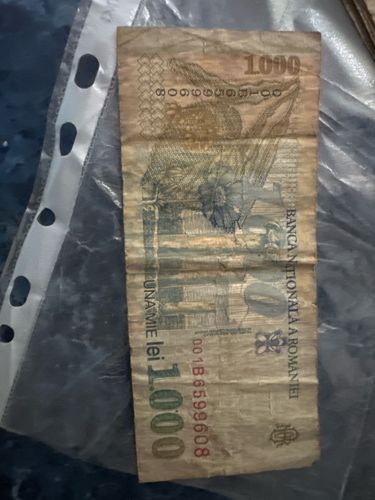1000 Lei Banknote (1998-2001 issue)
Country of Origin: Romania
Year of Issue: Circa 1998 (Note the serial number indicates it could be from a series issued into the early 2000s, but the primary design is from the 1998 series)
Denomination: 1000 Romanian Lei (ROL)
Composition: Paper (banknote)

Brief Description
The banknote appears worn and creased. The obverse side displays a portrait which, for this denomination and era, is typically Mihai Eminescu, a famous Romanian poet. The reverse side usually features significant Romanian cultural or architectural elements. The visible text includes 'BANCA NATIONALA A ROMANIEI' (National Bank of Romania) and 'UNA MIE lei 1.000', indicating its denomination. Serial numbers are visible as well.
Historical Significance
This 1000 Lei banknote was part of Romania's currency during a period of significant economic transition after the fall of communism. Romania experienced high inflation during the late 1990s and early 2000s, which led to high denomination banknotes like this one becoming common. This particular note would have been used before the major currency redenomination in 2005, when 10,000 old Lei (ROL) became 1 new Romanian Leu (RON). These notes are a tangible representation of Romania's post-communist economic challenges and subsequent stabilization efforts.
Estimated Value
The estimated value of this particular 1000 Lei banknote is relatively low due to its heavily circulated condition. In this worn state, it would likely be worth less than 1 USD, primarily as a collector's item for those interested in historical Romanian currency or hyperinflationary notes. Uncirculated or pristine examples would fetch more, but still not a significant amount.
Care Instructions
Given its current condition, further damage is likely. To preserve it: handle as little as possible, ideally with clean, dry hands or cotton gloves. Store flat in a Mylar sleeve or a similar acid-free, inert plastic holder designed for currency to prevent further creasing, tearing, or environmental degradation. Keep away from direct sunlight, extreme temperatures, and high humidity.
Created At: 2025-09-06T12:26:21.002392